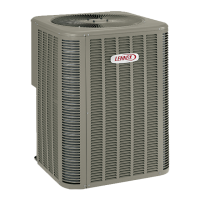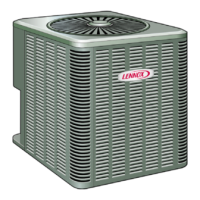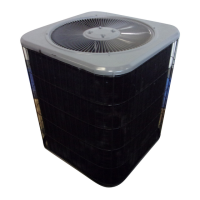Page 27
14HPX SERIES
AMBIENT
SENSOR
Figure 16. Sensor Locations
DEFROST SYSTEM SENSORS
Sensors connect to the defrost board through a
field‐replaceable harness assembly that plugs into the
board. Through the sensors, the board detects outdoor
ambient, coil, and discharge temperature fault conditions.
As the detected temperature changes, the resistance
across the sensor changes. Figure 17 shows how the
resistance varies as the temperature changes for both type
of sensors. Sensor resistance values can be checked by
ohming across pins shown in table 5.
NOTE - When checking the ohms across a sensor, be
aware that a sensor showing a resistance value that is not
within the range shown in table 5, may be performing as
designed. However, if a shorted or open circuit is detected,
then the sensor may be faulty and the sensor harness will
needs to be replaced.
Table 5. Sensor Temp. / Resistance Range
Sensor
Temperature
Range °F (°C)
Resistance values
range (ohms)
Pins/Wire
Color
Outdoor
(Ambient)
-35 (-37) to 120
(48)
280,000 to 3750 3 & 4
(Black)
Coil -35 (-37) to 120
(48)
280,000 to 3750 5 & 6
(Brown)
Discharge (if
applicable)
24 (-4) to 350 (176) 41,000 to 103 1 & 2
(Yellow)
Note: Sensor resistance decreases as sensed temperature increases
(see figure 17).
Coil Sensor—The coil temperature sensor (shown in figure
16) considers outdoor temperatures below -35°F (-37°C) or
above 120°F (48°C) as a fault. If the coil temperature sensor
is detected as being open, shorted or out of the temperature

